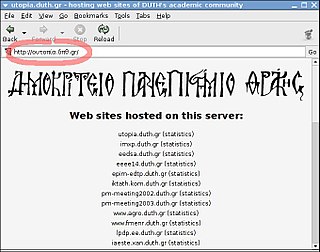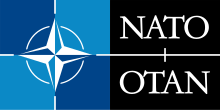
The Internet Corporation for Assigned Names and Numbers is an American multistakeholder group and nonprofit organization responsible for coordinating the maintenance and procedures of several databases related to the namespaces and numerical spaces of the Internet, ensuring the network's stable and secure operation. ICANN performs the actual technical maintenance work of the Central Internet Address pools and DNS root zone registries pursuant to the Internet Assigned Numbers Authority (IANA) function contract. The contract regarding the IANA stewardship functions between ICANN and the National Telecommunications and Information Administration (NTIA) of the United States Department of Commerce ended on October 1, 2016, formally transitioning the functions to the global multistakeholder community.
A top-level domain (TLD) is one of the domains at the highest level in the hierarchical Domain Name System of the Internet after the root domain. The top-level domain names are installed in the root zone of the name space. For all domains in lower levels, it is the last part of the domain name, that is, the last non empty label of a fully qualified domain name. For example, in the domain name www.example.com, the top-level domain is .com. Responsibility for management of most top-level domains is delegated to specific organizations by the ICANN, an Internet multi-stakeholder community, which operates the Internet Assigned Numbers Authority (IANA), and is in charge of maintaining the DNS root zone.
In the Internet, a domain name is a string that identifies a realm of administrative autonomy, authority or control. Domain names are often used to identify services provided through the Internet, such as websites, email services and more. As of 2017, 330.6 million domain names had been registered. Domain names are used in various networking contexts and for application-specific naming and addressing purposes. In general, a domain name identifies a network domain or an Internet Protocol (IP) resource, such as a personal computer used to access the Internet, or a server computer.
A domain name registry is a database of all domain names and the associated registrant information in the top level domains of the Domain Name System (DNS) of the Internet that enables third party entities to request administrative control of a domain name. Most registries operate on the top-level and second-level of the DNS.

The domain name .org is a generic top-level domain (gTLD) of the Domain Name System (DNS) used on the Internet. The name is truncated from 'organization'. It was one of the original domains established in 1985, and has been operated by the Public Interest Registry since 2003. The domain was originally "intended as the miscellaneous TLD for organizations that didn't fit anywhere else." It is commonly used by non-profit organizations, open-source projects, and communities, but is an open domain that can be used by anyone. The number of registered domains in .org has increased from fewer than one million in the 1990s, to ten million in 2012, and held steady between ten and eleven million since then.
The Internet uses the Domain Name System (DNS) to associate numeric computer IP addresses with human-readable names. The top level of the domain name hierarchy, the DNS root, contains the top-level domains that appear as the suffixes of all Internet domain names. The most widely used DNS root is administered by the Internet Corporation for Assigned Names and Numbers (ICANN). In addition, several organizations operate alternative DNS roots, often referred to as alt roots. These alternative domain name systems operate their own root name servers and commonly administer their own specific name spaces consisting of custom top-level domains.

.coop is a sponsored top-level domain (sTLD) in the Domain Name System of the Internet. It is intended for the use of cooperatives, their wholly owned subsidiaries, and other organizations that exist to promote or support cooperatives.

An internationalized domain name (IDN) is an Internet domain name that contains at least one label displayed in software applications, in whole or in part, in non-latin script or alphabet or in the Latin alphabet-based characters with diacritics or ligatures. These writing systems are encoded by computers in multibyte Unicode. Internationalized domain names are stored in the Domain Name System (DNS) as ASCII strings using Punycode transcription.
A domain name registrar is a company that manages the reservation of Internet domain names. A domain name registrar must be accredited by a generic top-level domain (gTLD) registry or a country code top-level domain (ccTLD) registry. A registrar operates in accordance with the guidelines of the designated domain name registries.
The domain name int is a sponsored top-level domain (sTLD) in the Domain Name System of the Internet. Its name is derived from the word international, characterizing its use for international organizations and treaty-related purposes. The first use of this domain was by NATO, which had previously been assigned the top-level domain .nato.
museum is a sponsored top-level domain (sTLD) in the Domain Name System of the Internet used exclusively by museums, museum associations, and individual members of the museum profession, as these groups are defined by the International Council of Museums (ICOM).
A country code top-level domain (ccTLD) is an Internet top-level domain generally used or reserved for a country, sovereign state, or dependent territory identified with a country code. All ASCII ccTLD identifiers are two letters long, and all two-letter top-level domains are ccTLDs.
Generic top-level domains (gTLDs) are one of the categories of top-level domains (TLDs) maintained by the Internet Assigned Numbers Authority (IANA) for use in the Domain Name System of the Internet. A top-level domain is the last level of every fully qualified domain name. They are called generic for historical reasons; initially, they were contrasted with country-specific TLDs in RFC 920.
The Uniform Domain-Name Dispute-Resolution Policy (UDRP) is a process established by the Internet Corporation for Assigned Names and Numbers (ICANN) for the resolution of disputes regarding the registration of internet domain names. The UDRP currently applies to all generic top level domains, some country code top-level domains, and to all new generic top-level domains.

.jobs is a sponsored top-level domain (sTLD) in the Domain Name System of the Internet. As indicated by its name, the domain is restricted to employment-related sites.
Prior to the globalization of the Internet, its assignment of domain names was administered within the research and academic communities through the Internet Assigned Numbers Authority (IANA). As the Internet grew to a global service, in the 1990s, there was increasing pressure to add more "generic" top-level domain names, beyond the initial set, such as .com and .org and the two-letter country codes. Extensive debate within the Internet operational community did not resolve this. Finally, a composite group was formed, to create a proposal for the enhancement. The International Ad Hoc Committee (IAHC) was composed of members named by a variety of Internet and International sponsoring organizations.

.biz is a generic top-level domain (gTLD) in the Domain Name System of the Internet. It is intended for registration of domains to be used by businesses. The name is a phonetic spelling of the first syllable of business.
.global is a generic top-level domain (gTLD) and was delegated to the DNS root zone on June 6, 2014. The application for the new top-level domain was approved on April 17, 2014, and .global was made available to the general public on September 9, 2014.

.google is a brand top-level domain (TLD) used in the Domain Name System (DNS) of the Internet. Created in 2014, it is operated by Alphabet Inc., Google's parent company. It is notable as one of the first gTLDs associated with a specific brand. The company's first usage of the TLD was with com.google, an April Fools' Day joke website that hosted a horizontally mirrored version of Google Search. The domain currently hosts multiple Alphabet Inc. products and services, and plans exist to move other Alphabet properties to .google as well.
.vlaanderen is a generic top-level domain for Flanders, Belgium first introduced in 2014.







